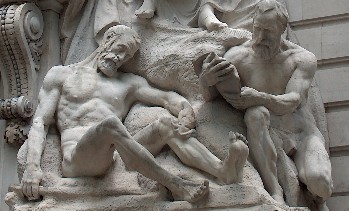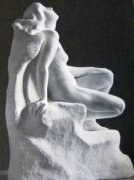Harold Parker (1873-1960/62)
Sculpture by Parker at the entrance of Australia House in the Strand.
The Australian/British sculptor Harold Parker divided his life and career between Australia and Britain, producing a fair number of ideal nudes, allegorical figures and other sculptural groups which can be found in both countries, before finally settling in Australia, and turning from sculpture to oil painting in his later years.
The sculptor Harold Parker was born in Aylesbury, but was taken as an infant to Australia, and it is there that he grew up. He studied at the Brisbane Technical College, and then, following the path taken by a previous generation of Australian-trained artists, came to England in 1896 and settled there. He continued as a student in London, first with W.S. Frith at the South London Art School, later assisting Thomas Brock and Hamo Thornycroft for at least some period, and also being associated with the sculptor John Tweed, and in the 1900s, having his studio in the Stamford Bridge Studios, Fulham, where he coincided with the sculptors Ferdinand Blundstone and S.N. Babb. He exhibited at the Royal Academy from 1903 through to 1947, also showing works at the Paris Salon. He became a member of the Society of British Sculptors in 1906, but despite being nominated later three times to the Royal Academy, was unsuccessful on each occasion. In 1908 his Ariadne was bought under the terms of the Chantrey Bequest; there is a smaller version of the same piece in the National Gallery of Art in Victoria, Melbourne. This, along with the commissions for Australia House in the 1910s noted below, represent the most successful period of his career.
Nudes, often in the form of mythological and allegorical figures, formed a large part of his output, along with portraits, and a few sculptures of animals. In his figure sculpture, he had a particular interest in the musculature and surface forms. It is telling that while some of his earlier figure sculpture is in bronze, his later works seem to be mostly plaster, which is to say he was unable to interest buyers enough to have bronze versions made.
Important and powerful outdoor statuary by Parker in London can be found at the entrance to Australia House, on the Strand, in his groups Awakening of Australia and Prosperity of Australia (1913-18) (described on this page).
Parker was much feted in Australia, and in his later years, from 1930, returned there for good, living in Brisbane, but despite some reputation when he came, and exhibiting his sculpture along with paintings there, he found little enthusiasm for his statues, and he gradually turned more and more to oil painting, abandoning sculpture, and later, it seems, retiring from exhibiting altogether.
Typical nudes by Harold Parker.



